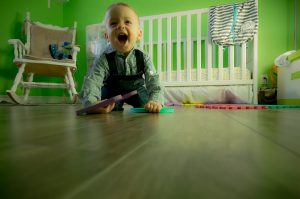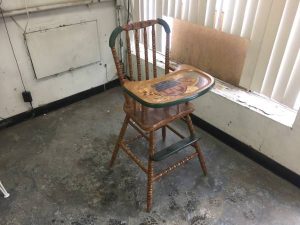
Source: Pixabay.com
When’s the best time to begin baby proofing? You might think (duh)…right before your baby starts cruising, at about 6 months of age or so.
But how about when you’re shopping for baby gear? That’s right. Baby proofing starts in the store.
Gearing up and baby proofing go together like macaroni and cheese. Consider: In 2016, nursery products were associated with roughly 62,300 injuries in children under age 5 who were treated in U.S. hospital emergency departments, according to the Consumer Product Safety Commission (CPSC).
That’s a lot, which is why it’s important to buy the right products and use them correctly–and skip stuff that can be a safety hazard. Here’s a rundown of four baby products that year after year, have the worst safety track record, according to the CPSC, and how sharpening your shopping skills can help keep your baby safe.
Smart shopping + Baby Proofing = Safer Haven
High Chair
According to the CPSC, 13,400 children were treated for high chair injuries in 2016. It’s trending upward. Most of the injuries result from falling out of the chair because the safety straps weren’t used. Gary Smith, M.D. and his team at the Nationwide Children’s Hospital in Columbus, Ohio underscore the hazard of high chairs. Their research shows an average of 24 children are treated in a U.S. emergency department daily for an injury related to a high chair or booster seat.
Baby proofing/shopping plan
Buy:
- A high chair with a crotch strap and a safety harness that’s separate from the tray, like this one, which has a convertible 3/5 point harness.If you’re short on space, get a certified booster high chair, which straps to a regular chair instead of a regular, full-size high chair. A folding high chair is a great option, too! (Look for the JPMA seal.)
Look for:
The JPMA seal. High chairs sold in the U.S. should meet ASTM voluntary safety standard F404. To be sure your contender high chairs does, the JPMA seal
The seal is peace of mind. It signifies that the product has been tested at an independent lab to guarantee that it meets ASTM standards, federal and state laws and some retail requirements.
High chair brands with the JPMA seal: Aria Child, Baby Bjorn, Baby Trend, Chicco, Delta, Evenflo, Fisher Price, Graco, Joovy, Keekaroo, OXO, Pali Design, Peg Perego and Summer Infant. JPMA certifies baby products in a total of 24 categories. Click here for a list of JPMA-certified products.
Don’t buy:

A used high chair, especially if it has a broken or missing safety harness or center post and/or a tray that doesn’t lock into place.
This “vintage” high chair, for example, was for sale on Craig’s list at press time. In general, vintage and baby gear is a bad combo.
Skip this safety shortcut: Some parents forego the high chair safety harness and just use the tray. Nuh uh. Use both. The tray isn’t a seat belt by itself, but with the seat belt, it is an added safety measure.
Strollers
In September 2015, stroller safety standards were updated and it seems to be making a difference. Strollers were associated with 10,000 injuries in the U.S. in 2016, which is down from 10,700 in 2015. Yay!
Baby proofing/shopping plan
Buy:
A new stroller so you can take advantage of one with the most recent and extensive safety updates.
Look for:
The JPMA seal. JPMA certified stroller brands include Aria Child, Baby Trend, Bugaboo, Chicco, Delta, Dorel Juvenile Group (Safety 1st), Evenflo, Graco, Joolz, Joovy, Kolcraft, Nuna, OXO, Peg Perego, Summer Infant, UPPAbaby, Veer Geer and WOW! Brand.
Skip:
A used stroller. It may pre-date the 2015 stroller safety standard updates.
Tip: The stroller options are dizzying. To narrow the field, first decide which infant car seat you’d like to use, then match it with a corresponding stroller. Or, better yet, turn your car seat into a stroller with a stroller frame. An infant car seat + stroller frame is a good first step. It buys you time. After your baby outgrows her infant car seat, then you can go shopping for the next-stage stroller.
Cribs/mattresses
Cribs and crib mattresses are right up there with injuries, causing 11,300 annually and 36 deaths. The main issue? Putting extra bedding in the crib–pillows, blankets and a comforter. A cushy nest is not a safe sleeping environment. Bare is best.
Baby proofing/shopping plan
Buy:
A new, stationary-sided crib (with no moving parts) and take the time (at least a half hour or so) to assemble it correctly, if it doesn’t come pre-assembled. All new cribs sold in the U.S. must meet the same safety standards. You can buy a good, safe crib for as low as $130 (not including the mattress; sold separately).
The firmest crib mattress you can find. Think brick. Babyproductsmom is a big fan of Colgate crib mattresses because manufacturing crib mattresses are what they do—and have been since 1955. There are lots of Colgate mattresses to choose from. If you’re on a big budget, just go to Amazon and select the least expensive Colgate mattress you can find.
A tight-fitting fitted crib sheet. Make sure the sheet fits your mattress snugly. (Think drum.) Colgate recommends this brand of crib sheet for its mattresses, for example, because it fits well. But any crib sheet will do as long as it fits snugly.
Sleep sacks. Use them instead of a baby blanket in your baby’s crib. Buy 2 to 3 swaddle wraps, which should do you for the first few months and then and 2 or 3 sleep sacks in size medium for later.
Look for:
The JPMA Seal. JPMA certified cribs and play yards include AFG Furniture, Aria Child, Chicco, Baby Trend, BabyBjorn, Bassett Furniture, Bivona, Sorelle, Creative Baby, Delta, Dorel, Dream on Me, Evenflo, Graco, Heritage Baby Products, Joovy, Kolcraft, Korbex, M Design Village, Pali Design, Pt. Domusindo Perdana, Shermag, Stork Craft, Summer Infant and Westwood Design.
Don’t buy:
A used crib with sides that go down (a.k.a. a drop-side crib). It’s illegal to sell drop-side cribs in the U.S. but you still can find them at garage/tag sales—for next to nothing. A drop-side crib is a bad deal, no matter the cost.
A vintage crib or bassinet. “You have to be careful about hand-me-downs. Things that worked for the last generation may not be safe for this generation, especially cribs,” says Pat Gabbe, MD, a pediatric safety expert at The Ohio State University Wexner Medical Center.
A mattress topper (I’m linking only to show you what one looks like). Any extra padding in the sleep environment is a suffocation hazard. Suffocation in the leading cause of babies in their first year. In general, for the safest sleep environment, keep in mind, “bare is best.”
Extra bedding, such as sleep positioner, crib bumpers, pillows for the crib or play yard. No matter how cute, don’t buy this stuff. It’s crib clutter and a suffocation/entrapment hazard.
If you buy…
A crib mobile, hang it out of your baby’s reach and remove it from the crib when your baby is 5 months old. “That’s when babies can get up on their knees and reach it,” Dr. Gabbe says. Radar: Choking/suffocation hazard.
Infant car seats
Infant car seats were connected with 9,000 injuries in 2016 and 8 deaths (not due to car accidents). Most of the injuries result from falls—either babies tumble out of the car seat because they weren’t strapped in or the seat falls with them strapped in it–or from placing the infant car seat with baby on a soft surface.
Baby proofing/shopping plan
Buy:
A new car seat. That way, you’ll know the car seat meets the latest safety standards and that it hasn’t been in an accident.
Don’t buy:
Car seat covers, inserts, tightening devices, toys or other accessories that aren’t approved by the car-seat manufacturer. In the event of a crash, these untested items could injure your child by weakening the restraint system or becoming projectile.
Don’t fall for it. No matter which type of infant car seat you buy, don’t put an infant car seat (with your baby in it) on an elevated surface, such as the kitchen counter or the dining room table. Keep it on the floor. Use the safety straps every time, even if your baby is just napping in the seat at home. The same goes for a bouncy seat. Bouncy seats were associated with 10 deaths from 2012 to 2014 because of seat tipovers because of placement on a soft surface and falls.
Don’t forget this step…
After shopping for your baby gear, be sure to fill out and send in the registration card. Most infant and toddler products sold in the U.S. must be accompanied by one. Completing one for each baby product you buy can helps manufacturers easily notify you in the event of a recall because no matter how careful a shopper you are, stuff can happen.
Recap:
- Know that high chairs, strollers, cribs/mattresses and infant carriers top the list of products associated with injuries that send babies to hospital emergency departments.
- Babyproofing starts in the store, before your baby is born, with the products you buy (and what you don’t).
- Buy a new high chair and use the safety straps every time. Don’t depend on the tray to do the job.
- Buy a new stroller so you know your getting one that’s manufactured after 9/15/2015, when the latest safest standards were updated and implemented.
- Buy a new crib and keep out the clutter, as in blankets, pillows, toys, a sleep positioner and a bumper. Cozy is not cool.
- Buy a new car seat and keep it off the counter, bed and sofa. Same goes for the bouncy seat.
- Look for the JPMA seal when you’re shopping for a high chair, stroller, crib and playyard. When you’re comparing models, the seal is a shortcut to safety.











[…] my previous post, you know that babyproofing starts when you’re shopping for baby gear. But after you’re […]